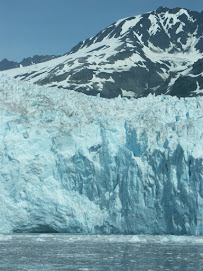1. In this area summer heating produces average maximum temperatures in the upper 70’s with extreme readings in the 90’s.
http://www.wrcc.dri.edu/narratives/ALASKA.htm
2. On June 21st, the North Pole is tilted towards the sun. As the earth rotates on it’s axis, the sun appears to move in a low circle in the sky. It only dips below the horizon for a few short hours. Although, the sun is never showing at midnight in Denali, you would have to go further north above the Arctic Circle for that, it does stay light out for 21 hours. When the sun sinks below the horizon, it does not get really dark but just stays a gray dusk clled twilight
3. They are:
a. Pacific Mountain System – Southern Coast and String of Islands
b. Rocky Mountain System -North of the Central Uplands and Lowlands area (includes Brooks Range and the Brooks Range foothills)
c. Central Uplands and Lowlands - Between the Pacific Mountain System in the south and the Brooks Range of the Rocky Mountain System in the north
d. Arctic Coastal Plain: The northernmost geographic area, north of the Rocky Mountain System and slopes gradually toward the Arctic Ocean.
http://www.netstate.com/states/geography/ak_geography.htm
4. they are
a. the pacific ocean
b. arctic ocean
c. the gulf of Alaska
5. plate tectonics
6. There are an estimated 100,000 glaciers in the State
http://www.susanmilne.com/glacier/glacier.htm
7. A glacier is a large, slow moving river of ice, formed from compacted layers of snow, that slowly deforms and flows in response to gravity.
8. at a point in the glaciers’ time it gets too heavy. At that point in time it looses
9. The rate of melting exceeds the new snow accumulating during the winter months. Many scientist believe this is a product of global warming.
10. the blue is caused by the snow’s absorption of red and yellow light
11. the Dena’ina Mountain Range
12. The taiga is found throughout the high northern latitudes, between the tundra, and the steppes.
13. The tundra replaces the taiga when you have passed the northern tree line
14. what helps them survive in this harsh environment are:
a. warm, fur hides
b. heat-efficient body shape
c. growth and reproduction
d. camouflage
e. hibernation
f. using snow as insulation
15. 1500
16. cold, partly in a permafrost
17. they are:
a. the Black tailed dear
b. Alaskan moose “the Godzilla of the deer family
c. Kodiak deer
d. Raspberry deer
18. there is estimated to be 7,000-11,200 in alaska and over 5,000 in the lower 48 states. Around the world there are estimated to be around 200,000 in 57 countries, compared to up to 2 million in earlier times
19. there are the:
a. stellar sea lion
b. rough eye rock fish
c. halibut
d. arrow-tooth flounder
e. pacific cod
20. There are the:
a. Beluga whale
b. Grey whale
c. Harbor porpoise
d. North pacific right whale
Saturday, April 19, 2008
Subscribe to:
Post Comments (Atom)




No comments:
Post a Comment